Rajasthan Board RBSE Class 12 Biology Notes Chapter 9 Enzymes
Introduction
1. Proteinaceous organic compounds which act as bio¬catalysts in biochemical reactions are called enzymes.
2. Enzymes are bio-catalysts and accelerate the rate of biochemical reaction directly or indirectly by decreasing the activation energy of reactants.
3. Enzyme is a Greek term and it literally means “In Yeast”
(En = in, Zyme = yeast)
4. The branch of biochemistry which deals with the study of enzymes is known as enzymology.
5. Enzymes are called bio-catalysts or biochemical catalyst. Chemically all enzymes are made up protein, and increase the rate or efficiency of biochemical reaction and themselves do not undergo any change during the reaction.
![]()
6. The reactions taking place in the cell, which are related with synthetic activites and use energy’ are called anabolic activities.
7. The reactions which are related with break down activities and release energy are called catabolic activities.
8. Together these two activities lead to the metabolic pathway of the cell and are called metabolic activities.
9. The existence of biological system depends on the co-ordinated effect of a series of complex and specific biochemical reactions which are governed by specific enzymes.
History of Enzymes
- Bergelius (1835) was first to identify enzymes as biocatalysts.
- Kuhne (1878) coined the term enzyme for the substance which brings about fermentation of sugar solution.
- Buchner (1897) discovered that fermentation of sugar solution is brought about by crushed yeast cells and discovered “Zymase” enzyme.
- Sumner (1926) isolated an enzyme “Urease” in pure crytalline form.
- Sumner and Northrope (1930) established that all enzymes are made up of proteins.
- Sumner, Northrope and Stanley were awarded with Nobel Prize in 1947 for their work related with protein nature of enzymes.
- Emil Fishes (1894)- proposed lock and key theory for explaining mode of enzyme action.
- Northrope and Kuntz (1936), crystallized Pepsin, Trypsin and Chymotripsin enzymes.
- Koshland (1966) proposed induced fit model theory for explaining mode of enzyme action.
- T. Cech and Altman discovered a non-proteinaceous enzyme which has been naemd as ribozyme
(Enzyme of RNA).
![]()
Structure of Enzyme
- All enzymes are chemically made up of proteins but all proteins are not enzymes.
- The enzyme which helps in splicing of RNA is named as ribozyme and is made up of RNA.
- A large many enzymes are exclusively made up of protein (Pepsin, Urease etc.)
- Such enzymes which are made up of only protein are called simple enzymes.
- In many enzymes a non protein part is also attached to the protein part. Such enzymes are called conjugated or holoenzymes.
Thus the conjugated enzyme has two parts :
- The protein part
- The non-protein part
The protein part of the conjugated enzyme is called apoenzyme.
The non protein part of the conjugated enzyme is called co-factor and may be of three different types :
- Prosthetic group
- Co-enzyme
- Activator
Prosthetic Group
- When the non protein part attached with the apoenzyme is an organic compound and is firmly bonded with the protein part, it is called as prosthetic group.
- The prosthetic group can not be separated from the protein part (apoenzyme) without denaturation of protein.
Example-Cytochrome, Flavoprotein.
Co-enzyme
- When the non protein part is an organic compound and is only loosely attached with the protein part (apoenzyme), it is called as co-enzyme.
- The co-enzyme can be easily separated from the protein part and can be easily attached again with it. Example- Co-enzyme A, NAD. FAD, NADP etc.
Activator
- When the non-protein part is an inorganic substance such as some metal ion or mineral ion, it is called as activator.
- The main role of the activator is to form a bond between the enzyme and the substrate molecule
Example, -K, Cu, Ain, Fe Zn, Ca etc.

Note : The main part of the holoenzyme or conjugated enzyme is made up of protein and it is called apoenzyme. The size (dimention) of the protein molecule and the sequence of amino acids varies in different enzymes.
- As the proteins are colloidal in nature, they have large surface area per unit volume.
- The protein part of the enzyme contains one or more specific sites called active sites.
- During enzymatic activity, the substrate molecules attach at these active sites.
- In the holoenzyme or the conjugated enzyme, the enzymatic activity is brought about by the holoenzyme.
- The apoenzyme alone or the nonprotein part alone can not act as enzyme.
![]()
Properties of Enzymes
- Enzymes are not distributed uniformly in all cells.
- Enzymes involved in respiration reactions are found in mitochondria and those involved in photosynthesis reactions are found in chloroplasts.
Note 1 : On the basis of detailed study, the properties of enzymes are as follows :
(i) Protein Nature : Chemicall almost all enzymes are made up of proteins. In some cases a non-protein part (organic or inorganic) may be attached with the protein part.
(ii) Colloidal nature : All enzymes are colloidal and have high molecular weight. On account of large surface area, the enzymes provide large space for binding with the substrate. Hence are able to accelerate the rate of reaction.
(iii) Specificity : Enzyme show specificity for the reaction they catalyse. An enzyme catalyses one specific reaction or is active on a specific substrate molecule. Only some enzymes can catalyse two or more than two types of reactions or can act upon more than one type of substrates. Generally enzyme specificity may be of following type :
(a) Absolute specificity : Such enzymes catalyse only one type of reaction on a specifc substrate molecule. Example : Urease catalyses hydrolysis of Urea.
(b) Group specificity : Some enzymes act upon a group of related substrate molecules. Example : Hexokinase acts on different types of hexose sugars.
(c) Bond specificity : Some enzymes act upon specific type of bonds. Example : Ribonuclease brings about hydrolysis ofphosphodiester bond at 3 ’ prime site of pyrimidine base.
![]()
(d) Stereo specificity : Some enzymes show activity on specifc stereo isomers of substrate and not on other. Example Amino acid oxidase catalyses reaction on only levo (L)-form of amino acids and not on (D) form of amino acids.
(iv) Thermo labile nature : Enzymes are sensitive to heat. In liquid medium, at a high temperature of 60 -70°C denaturation of enzymes takes place. Most suitable temperature for enzyme action is between 20°-35°C.
(v) Reversibility of reaction : Enzyme governed reactions are normally reversible, meaning by that the reaction may take place in both directions.
(vi) Catalytic behaviour: Enzymes are present in very small amount and are able to accelerate the rate of reaction. One molecule of enzyme may act upon 5 lac molecules of the substrate per minute. This value is called turn over number.
(vii) Enzyme optima: Most enzymes show optimum activity- under specific conditions of pH, temperature and concentration of the reactants. This is called enzyme optima.
(viii) Amphoteric nature : Enzymes may act on both acidic as well as alkaline reactants. This property is due to amphoteric nature of protein part of enzyme.
(ix) Enzyme inhibition: The enzyme activity may be reduced or inhibited by the effect of some substances other than the normal substrate. Such substances are called enzyme inhibitors.
Factors affecting Enzymatic action
(a) Temperature : Enzymes are highly sensitive to temperature. Majority of enzymes show optimum activity between 20°C to 35°C. In this range a rise in temperature by 10°C, the rate of enzyme activity may increase 2 to 2Vz times. Below 20°C & above 35° the activity of enzyme shows a decline, and stops below 0°C and above 60°.

(b) Concentration of Substrate : Increase in concentration of substrate results in to increase in rate of enzyme activity up to a certain limit. The rate of reaction becomes stable at optimum concentration of the substrate.
(c) Hydrogen ion concentration (pH) : All enzymes are sensitive to pH of the medium. Each enzyme shows optimum activity at a specific pH. A shift from this value, adversely affects the enzymatic activity. Most enzymes are known to act in the range of 5.0 to 7.5 pH. Example— Maltose 7.0; Amylase 7.0; Peroxidase 5.0; Urease 7.0; Tripsin 8.0.

(d) Enzyme concentration : Increase in amount of enzyme results in to increase in rate of reaction till the amount of substrate becomes limiting factor.Rate of reaction is directly proportional to enzyme concentration till the amount of substrate becomes limiting factor.
(e) End product concentration : Accumulation of the end product of the reaction results in to decrease in rate of reaction. When concentration of reactants reaches a state of equibrium, the enzymatic activity may stop and the reaction may proceed in backward (reversible) direction This is called feedback inhibition.
![]()
(f) Enzyme inhibitors : Some chemical substances inhibit the enzyme activity. These substances are called enzyme inhibitors and are of two types.
(i) Competitive inhibitors: These substances have structure closely similar to the structure of the substrate molecules. Hence these substances compete with the substrate in binding with the active site of enzyme. This results in to decrease in enzyme activity. Example : Malonic acid is competitive inhibitor of succinic acid. The effect of this kind of inhibition can be overcome by increasing the concentration of substrate.
(ii) Non-competitive inhibitors : Some substances do not show resemblance in structure with substrate molecule but attach with the active site of the enzyme permanently and bring about structural changes in their configuration.
These inhibitors permanently block or destroy the active site and thus act like poisiou. These are called non competitive inhibitors or enzjnte poisios. Example : Pb++ ,Hg++, Ag++ etc.
Note: Cyanide causes denaturation of cytochrome oxidase enzyme which is used in respiration reactions and thus acts as poison. The effect of non-competitive inhibitors can be overcome by increasing the concentration of enzyme.
Mode of Enzyme Action
The mode of enzyme action depends upon the nature of the enzyme and the substrate molecule, and it can be understood byr following :
(A) Formation of enzyme substrate complex. (ESC)
(B) Lowering of activation energy.
(A)Formation of Enzyme Substrate Complex (ESC) :
- In all enzyme goverened reactions the enzyme and the substrate combine to form an unstable complex called enzyme substrate complex. (ESC)
- This complex dissociates in to the product and the enzyme.
Enzyme + Substrate → Enzyme substrate complex.
Enzyme substrate complex → Enzyme + Product!s).

- On the surface of each enzyme several specific arease are found. These are called active sites,
- The substrate molecules combine with the enzyme at these sites.
- When the substrate molecules combin at the active sites, they can easily react with each other fonning the product.
- The product formed by’ formation of new bonds, dissociate from the enzyme.
- The enzyme becomes free to bind with other molecules of the substrate and new enzyme substrate molecule complex is formed.
The mechanism of formation of enzyme substrate complex, and the property of specificity of enzyme has been explained by following theories.
![]()
1. Lock and Key Theory :
- This theory was postulated by Emil Fisher (1898).
- According to this theory’, as a lock can be operated by it’s key only, similarly a specific substrate having a specific structure only can bind with the specific active site present on the surface of a specific enzyme.
- The enzyme remains unchanged after the product is released.

2. Induced Fit Model Theory :
- This theory has been proposed by Daniel Koshland (1966).
- According to this theory the shape (structure) of active sites found on the surface of enzymes is not rigid but flexible.
- These active sites are initially not complementary’ to the substrate molecule, but as a speeifc substrate molecule comes in close proximity of the enzyme, it induces a change in the organisation of the active site and binds with it.
- hi other words it can be said that the configuration of active sites is not fixed or rigid as has been stipulated in lock and key theory, but is flexible and when a. specific substrance comes in contact, the active site undergoes a minor change and becomes complementary to the saubstrate molecule.
- Thus enzyme substyrate complex is formed between a specific substrate with a specific enzyme only.

Enzyme.
- This theory stipulates that there are two operative groups in the active sites one helps in binding of the substrate molecule and the other acts to convert the substrate into product.
(B) Lowering of Activation Energy :
- All chemical compounds require input of a certain amount of energy for initiating a chemical reaction. This energy is called activation energy.
- Enzymes have the ability to reduce the energy required for the activation of the molecule.
- Hence in the presence of enzyme thfe reactant substrates are converted into product with much lesser input of energy.
- On an average the enzymes reduce the activation energy by approximately 65%.
- It is because of this that a reaction which takes place at high temperature outside the cell, takes place in the cell at atmospheric temperature with the help of enzyme.

Nomenclature of Enzyme
- Generally enzymes are named after the name of the substrate on which they act or the type of reaction which they catalyze.
- According to proposal by Duclaux (1883), enzymes should be named by adding the suffix-ase to the name of the substrate involved or the kind of chemical change they govern.
The following methods of nomenclature of enzymes are in practice:
(i) Nomenclature based on substrate : According to this usual practice suffix-ase is added to the name of the substrate on which they act. Example, enzymes acting on sucrose, maltose and lipids have been named as Sucrase, Maltase and Lypase respectively.
(ii) Nomenclature based on chemical reaction : According to this, enzymes are named on the basis of their enzymatic activity. Example: Enzymes which bring about, hydrolysis, oxidation, reduction, carboxylation are named as Hydrolases, Oxidases, Reductase and Carboxylases respectively.
(iii) Nomenclature based on substrate and chemical reaction: According to modem method of nomenclature, enzymes are named on the basis of both the substrate they catalyze and the nature of chemical reaction they govern. Example Succinate dehydrogenase enzyme acts on succinic acid and brings about it’s dehydrogenation.
![]()
(iv) Conventional names : In some enzymes, suffix-ase- is not added and the convemtional or traditional names have been retained and are in practice. Example : Pepsin, Trypsin Chymotripsin etc.
(v) Systematic and Coded nomenclature : Modern Nomenclature.
International Union of Biochemistry (1955) and Commission on Enzymology (1961) proposed a method of giving a systematic name to the enzymes. In this method besides the substrate on which it acts and the type of the reaction the enzyme governs, some other information is added in the form of Code number, called as E.C. Code.
- Accordingly each enzyme is given a specifc code number comprising of four digits.
- The first digit indicates its class, the second digit refers to the subclass, the third digit depicts the sub-sub class where as the fourth digit indicates its common name.
Example : Systematic name of hcxokinasc is ATP: Dhexoc, 6 phosphotranfcrase and systematic name of urease is Urate : 0, oxidorcductase.
Classification of Enzymes
International union of biochemistry (IUB) has classified enzymes in six main divisions and each enzyme has been given a numerical number called as Enzyme code (EC). The six division are as follows :
1. Oxido-reductases : All those enzymes which catalyze oxidation reduction reactions are included in this category. They catalyze the removal or addition of hydrogen, oxygen or electrons from the substrate or to the substrate and thus bring about oxidation or reduction.
Note: On the basis of their activity these can be divide in to three sub groups :
(a) Oxidases : These bring about oxidation of the substrate by transferring hydrogen from the substrate molecule to oxygen. Example : Cytochrome oxidase, Ascorbic acid oxidase etc.

(b) Dehydrogenases : These enzymes bring about oxidation of substrate molecule by removal of hydrogen from substrate as follows : Example – Lactate dehydrogenase; Alcohol dehydrogenase.
![]()
(C) Reducatses: These enzymes cause addition of hydrogen or electron to the substrate and removal of oxygen.
![]()
2. Transferases : These enzymes catalyze transfer of a group (amino, phosphate, methyl, ketone etc.) from one molecule to another molecule. Example : Transphosphatase; Transaminase.
3. Hydrolases : These enzymes catalyze the addition or removal of water. They hydrolyse a variety of compounds and generally bring about cleavage of the substrate. This group includes digestive enzymes. Which breakdown macromolecules into smaller molecules. Example : Carbohydrase, Amylase, Nuclease, Esterase etc.
Most hydrolytic reactions are reversible. These types of enzymes may also condense small moelcules to form macromolecules. In such reactions water molecule is released. Example-Fumarase, Enolase etc.
![]()
4. Lyases : These enzymes catalyze removal of a group from their substrate molecule by breaking special type of co-valent bonds without hydrolysis. Example. Aldolase.
5. Isomerases : These enzymes catalyze intramolecular reorganisation in the substrate molecule and convert the substrate into its isomer. Example – Phosphohexoisomerase.
6. Ligases or Synthetases : These enzymes catalyze such reactions in which two compounds are linked together by forming co-valent bonds between the two. Example- Pyruvate carboxylase, Citrate synthetase.
